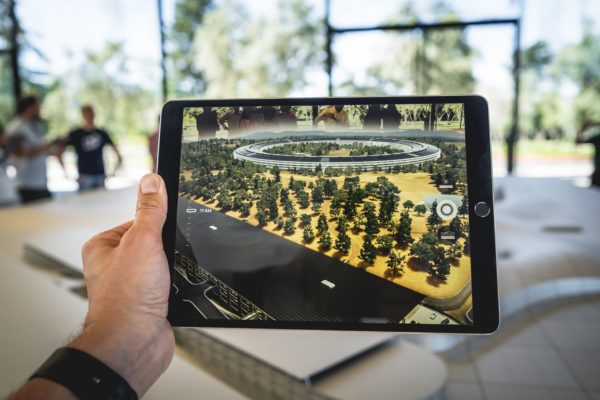In ‘Striking Vipers’, an episode from the latest season of ‘Black Mirror’, the protagonists use a futuristic virtual reality system for online gaming.
It allows them to fully inhabit a virtual avatar, where they can not only see the virtual space around them but interact with it kinaesthetically; all by simply adhering a sticky dot to the temple, the artistic depiction of futuristic neural interface technology.
For the characters in ‘Black Mirror’, the immersion experience is streamed straight to their neurons. But for the rest of us, headsets offer the most realistic experience possible.
From the Sword of Damocles to Google Cardboard
The first virtual reality headset was created in 1968, by computer scientist Ivan Sutherland.
Although the graphics consisted of simple wireframe rooms, the device was equipped with head tracking — the ability to alter graphics in response to the user’s gaze — via a mechanical arm suspended from the ceiling. Its nickname, ‘The Sword of Damocles,’ comes from the formidable appearance of this arm attached to the contraption.
Modern virtual reality headsets are much sleeker. Two screens are placed very close to the eyes, covering up to 110° of horizontal sight, tricking the mind into believing the user is immersed in another world.
Thanks to head tracking, the device can quickly render visuals to match wherever the user is facing within the full 360° space.

Dr Thuong Hoang, Lecturer in Virtual and Augmented Reality at Deakin University’s School of Information Technology, says devices such as the Oculus Rift and the Samsung Odyssey have become so accessible thanks to their use in the gaming industry.
“The gaming industry has brought headsets in at very popular levels,” he says. “For roughly $300, you can buy virtual reality headsets that would cost tens of thousands of dollars in prototypes a few decades back.”
Some major titles have been re-released into virtual reality, such as the viral horror game ‘Five Nights at Freddy’s,’ and the teamwork bomb-disabling game, ‘Keep Talking and Nobody Explodes’. There have also been games specifically designed for virtual reality use.
The popularity of the virtual reality headset has even prompted the creation of cheaper, simpler headsets, such as the Google Cardboard, which can be used to enjoy 360° YouTube videos by placing your phone into the cardboard holder.
The ultimate educational tool

But virtual reality is not just for recreational use. Dr Hoang says it has potential across industries as an educational tool.
First aid can be practiced in a controlled environment where no-one is at risk of harm. Users can simulate what it’s like to be employed in a particular line of work.
“The skills that people learn and the experiences that they gain in virtual reality stay with them, even after they’ve finished,” he says. “That makes it a prime candidate for training, especially skills training, or experiencing simulations.”
The use of virtual reality as an industry tool is particularly viable in the domain of health.
Dr Hoang says he’s seen virtual reality used as a distraction tool for children undergoing procedures without anaesthetic that could be painful or uncomfortable. They are transported into a virtual forest to help them stay calm.
It’s also been used for exposure therapy. Children with cancer have been able to see what it’s like to go under an MRI machine in a controlled environment, in order to acclimatise themselves to the experience.
The fully immersive nature of virtual reality, and how affecting the experience of it can be, makes it the perfect tool for empathy training.
“Research has definitely showed there is potential to increase empathy through the concept of virtual embodiment, in which the user identifies themselves with their virtual avatar,” Dr Hoang says.

Deakin’s EDIE, or Educational Dementia Immersive Experience, developed by researchers within the Applied Artificial Intelligence Institute (A2I2) with Dementia Australia, is a tool that can be used to train nurses and carers of people living with dementia.
By seeing the world through the eyes of someone with dementia, carers can better understand the challenges sufferers find in day-to-day activities.
This can better equip carers to identify and address seemingly ordinary objects around the home that a person with dementia may identify as a hazard or threat.
But what about the motion sickness?
One of the chief drawbacks to virtual reality is its propensity to cause motion sickness. Dr Hoang says this is caused by the sensory conflict the body can experience during virtual reality.
“We have a sense of awareness of where we are by receiving feedback from the five senses.
“People typically feel sick because they can see that they are moving, but the physical body does not receive the same feeling because they are stationary. It’s similar to being seasick on a boat,” he explains.

To counteract this, some virtual reality experiences provide additional sensory information that syncs into the visual elements.
This is the case for 4D cinemas found at some theme parks, where motorised seats and smells released into the theatre at key moments are used to enhance immersion.
Deakin’s VeRITy, or Virtual Reality Intrapartum Touch Trainer, employs the sense of touch to enhance the experience of using it.
Developed by researchers in the University’s CADET Virtual Reality Lab to teach nursing students to give adequate care to patients in labour, it involves a robotic technology in the shape of a pregnant woman that simulates birth contractions.
This is used in conjunction with a virtual reality software.
Dr Hoang says the reason why virtual reality is such an effective tool is because of the endless number of environments and scenarios that can be experienced within it.
“In virtual reality, you can simulate a completely synthetic environment, or experience any scenario that you might want to, including physically impossible ones, such as flying. That’s why it’s such a great training tool.”
Melina Bunting
Staff writer



